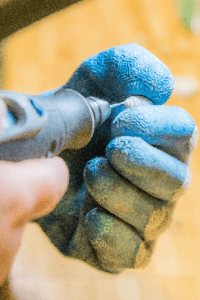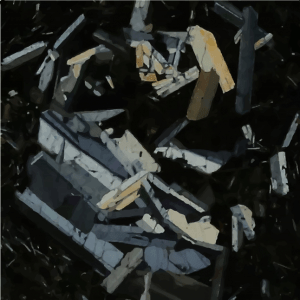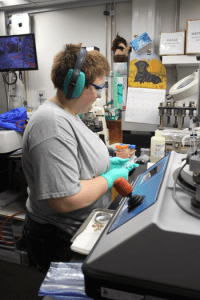
Slice and Grind
(post written by S. Moss)
Being out on a boat for two months at a time can sometimes leave you bored. No video streaming and limited internet means coming up with crafts and other ways to keep busy. During my month expedition aboard, the JR Academy was provided numerous activities from water coloring, karaoke, ping pong, and craft night.
I’ve decided to take craft night to a new level by making jewelry with Etienne Claassen. In the beginning of our journey, Expedition 385T started in Antofagasta, Chile. During our time there I collected many sea shells from the rocks of the mountains. From the mountains? Yes, that’s right, through the process of plate tectonics the ocean floor was pushed up and smashed into another plate creating a rise in land mass, thus making the mountains. Once part of the ocean floor, the shells now sit with me in my cabin on our way to San Diego.
With the help of Etienne I was able to use his Dremel and drill holes at the top of my shells. This will allow me to add wire and turn them into a pair of earrings once I reach home.

But one project was not enough for me. Once I finished my earrings I needed another, so I went to Luan Heywood with my leftover shells and we conjured up an idea. With the remaining shells we’ll make a second set of earrings. We laid them out in a star shape and poured dyed epoxy over top. Luan’s lab is made for making small thin sections of rock. To make a thin section we use the epoxy to “glue” the rocks onto microscope slides that then get sliced with a large saw. Once sliced they are grinded down to 30 micrometers (that’s 0.03 millimeters)! This allows light to travel through a rock so we can examine the minerals. The JR’s petrographic microscopes have a feature called cross-polarizing. This process bends the light and allows us evaluate the composition and three dimensional structure of a thin section. Several students are using this process for their research projects to classify minerals from samples of previous expeditions.

Once the epoxy dries we’ll be able slice the shell mixture in half and drill holes into them for jewelry wire.

But I’m not done yet! I went back to Etienne and made a shell necklace out of oyster shells found in Antofagasta. I’m on a roll and the resourcefulness of the scientists onboard only help me tumble… Maybe I’ll make a pair of rock earrings as well.